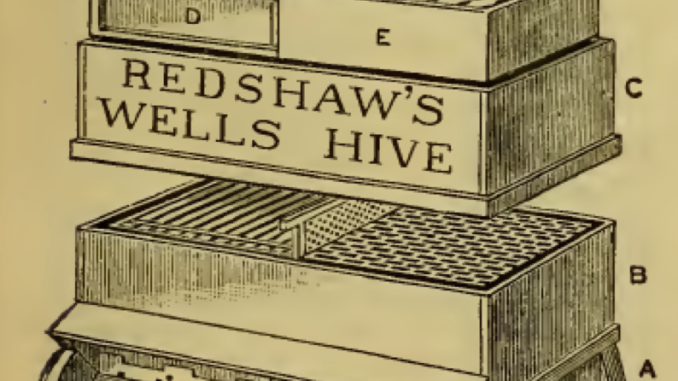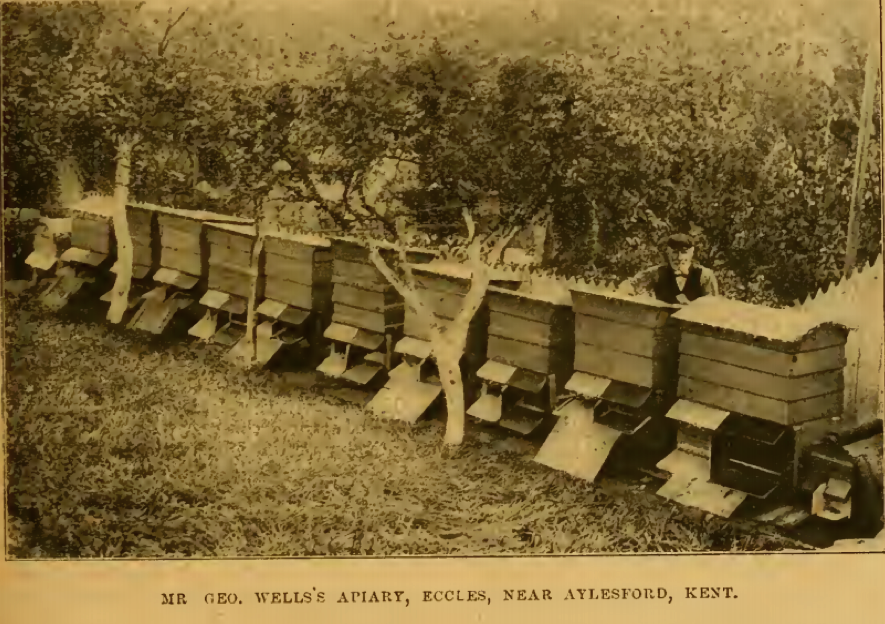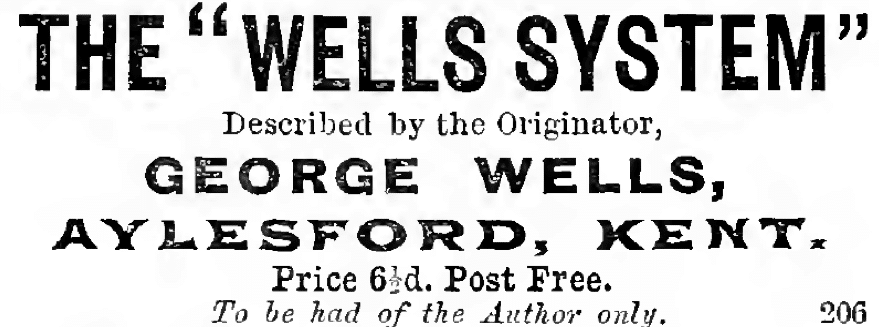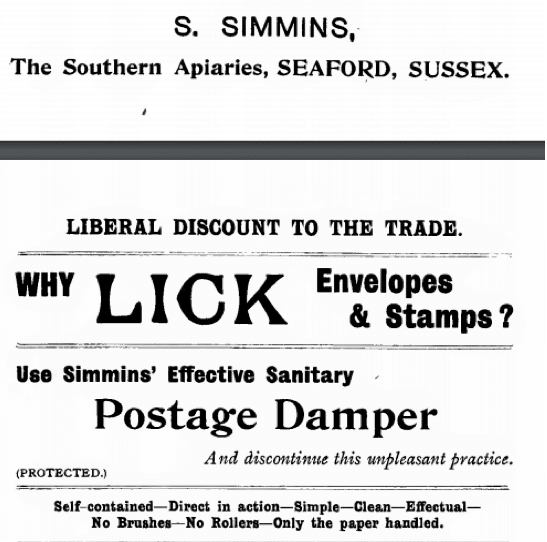
Alan Wade
In the last Bee Buzz Box we introduced ourselves to doubled hives, examining the essential difference between them and two-queen hives. We then explored the modern version of the doubled hive, one that can be easily set up in your back yard using standard gear to increase that winter honey store.

We now move on to the enigmatic history of the doubling process and its inventor, George Wells.
George Wells the apiarist
George Wells, a hitherto obscure Cottager beekeeper, burst onto the international beekeeping scene in early 1892. He had been working quietly on a backyard scheme, one that would out-fox every Cottager and Gentleman beekeeper seeking to make a living out of bees in Old Blighty. If you missed out on details of how to set up a doubled hive, check out Doubling Hives Part I – the last Bee Buzz Box Part I — at https://actbeekeepers.asn.au/bee-buzz-box-december-2019-doubling-hives-part-i-doubled-vs-two-queen-hives/
Wells’ 1890s rocket to fame arose out the fact that his hives were the most productive in all of Merry England. Never mind that an article from the West Gippsland Gazette alerting us of his legacy was thoughtfully lifted from the Farmer and Stockbreeder, a rag devoted entirely to British rural agricultural life and gentlemanly pursuits. A syndicated news report it may have been, but it’s a good read. Here is an excerpt:
Mr Wells, by accident or design, found out that by arranging for the circulation of air through the two stocks, and by keeping the queens in their own compartments, the bees would unite and work peaceably together in a common super…
In this way he produced immense stocks, and he was able to show returns in hive never known before in the British Isles.
‘By accident or design’ is a misnomer. Wells was a disciplined and well organised beekeeper to whom nothing came except of diligence and a willingness to think matters through and to do things well. The first details of his discovery come from the record of the Thursday 31 March 1892 Quarterly Converzatione meeting of The British Beekeepers Associationi. It reported verbatim on trials Wells had commenced in the spring of 1890. This revelatory conversation was continued within the confines of the Quarterly Converzatione at a follow up meeting of the British Bee-Keepers’ Associationii in April 1893.
Wells life became instantly frenetic but his generosity of spirit and willingness to support the beekeeping fraternity made him a living legend. In perusing hundreds of letters to the British Bee Journal and Beekeepers’ Adviser, we happened upon an April 1894 letter penned by a Helen Laurence from Leedsiii:
…The best results were got from the Wells hives; the one with the driven bees of 1892 giving me over 90 lb of honey, but no swarm. With some of that honey I took first prize at the Yorkshire Show, second at Goole, and commended at the Dairy Show, London, these being the only times I entered it for exhibition.
In another Wells hive (fifteen frames) I placed a swarm on June 16, on full sheets of foundation, and two days later another swarm in the other compartment. As honey was coming in so fast, and I was leaving home, I at once put on the excluder and shallow frames.
When I looked under the quilt on my return a fortnight later to see how the bees were getting on, I was astonished to find the frames full of honey, and all sealed over. Our honey returns were quite a revelation to some of the old bee-keepers here…
Using his new strategy Wells was producing both extractable and section comb honey from early spring.
George Wells the man
But what of George Wells as a person? He retired as a brick-maker foreman to take up beekeeping in earnest. He was one of those beekeepers you meet that has a sixth sense in reading bees.
He was also a gentleman, a lucid and generous communicator with a great sense of self assurance and modesty, well-capable of defending himself and who kept the most meticulous records. Perhaps his working-life experience as a brick-maker, enduring some of the radiant 1200 degree brick kiln firing heat, helped him fend off this most ardent critics!
We are fortunate in having a voluminous collection of his lettersiv and detailed responses to enquires from individual beekeepers most of whom were, like him, Cottager beekeepers. A close reading of wide-ranging correspondence on the Wells System shows that he not only really understood bees and that he knew that bees well-kept would out-perform those of most beekeepers but that he was really onto something with his discovery.
An excerpt of his February 1894 lecturev to a meeting of the Northumberland and Durham Beekeepers Association probably typifies his willingness to share his skills and ideas:
Mr Wells brought with him a double-queen hive, which he took to pieces before the audience, and, while describing his arrangements, gave many valuable hints to those interested in bees. In the course of his remarks he intimated that he had experimented for results with five single-queen hives v. five double-queen hives, and found that the single hives gave 205 lb of honey, or an average of 41 lb each, while the double hives gave 789 lb, or an average of 157 lb each.
That beekeepers’ associations sponsored many such meetings is indicated by a 1894 communicationvi:
Mr Wells is to be congratulated upon the complete success of these pioneer meetings. The addresses were admirably delivered, and embellished with homely wit, which kept the audiences in excellent humour.
A later visit to his apiary by esteemed members of the British Beekeepers Associationvii, adjudged that his bees were kept in immaculate condition. His setup later featured in the British Bee Journal series The apiaries of our readersviii.

Amongst the notes made by the visitors was the remarkable observation:
…Bee-keepers of experience will appreciate this fact because they know how seldom brood is found on the outside of outside combs in mid-April. Here, however, in every hive examined was plain evidence that the bees of both queens formed one continuous cluster, extending right through both brood chambers; the perforated divider inserted in the centre causing no break in it.
There were literally dozens of accounts of successful operation of double-queen Wells’ hives of which another example may suffice. In a report of a W Martin of High Wycombeix, a beekeeper who had unsuccessfully experimented with operating colonies with two queens, we hear of his discussion with another beekeeper who had had some resounding success:
Friend Nicholls (Letter 2058, p. 346)x, who I know very well, was at my place some time ago, and our talk as usual turning on bees, he complained of it being a bad year with him, and that he should have to feed. Yet on opening my journal I found to my surprise that he had been trying the Wells hive and had taken 183 lb. from it. And that, too, in a bad year, when some bees worked on the old plan were about starving! Then comes your correspondent, Wm Tustain (2069, p. 365), and beats friend Nicholls by 73 lb, with 256 lb from his Wells, so even with the 10 lb of sugar and the nice cake of candy that the hive wants for winter, it is a big take.
Such was the demand to explain his Wells System that George was scheduled to speak at five meetings in one week in early 1894xi:
The Committee of this Association regret that, owing to pressure of business, Mr G Wells could not fulfil his engagement to deliver addresses in Northumberland and Durham last December. Reports from local correspondents showed that his visit was awaited with extraordinary interest, and they therefore renewed their negotiations with him, and now have pleasure in announcing that, having made special arrangements, he will address meetings as follow: February 12, 1894, Newcastle in the Mining Institute, February 13, Consett Assembly Rooms; February 14, Whittingham Schoolroom, February 15, *Cambo. February 16, *Bedlington (Station). February 17, *Riding Mill
*These meetings are under the auspices of the Northumberland County Council. J.N. Kidd, Hon. Sec. N and DBKA
The dutiful Honorary Secretary, J N Kiddxii, was the author of the West Gippsland Gazette article that led us to this tale of rediscovery. We won’t delve into the intricacies of the Wells System, but a report of these meetings and more than a handful of annual reports detailing his honey production records, one experiment comparing the performance of single-queen and two-queen-colonies, were dutifully presented to the very august British Bee Journal.
Here is an advertisement for his pamphlet, a copy of which I have been unable to locatexiii:

Scattered through his journal letters were a multitude of advertisements from merchants seeking to cash in on his revolutionary hive design typified by the Redshaw’s Wells Hive illustrated as the feature imagexiv.
Wells contributed regularly to the British Bee Journal until his health dramatically and suddenly declined. His carefully kept annual production recordsxv appeared regularly in the journal from 1890 until 1900.
Wells also conducted a trial of ten single-queen and five two-queen-colonies reporting on his comparative experimentxvi. For the individual beekeeper, sceptical of his findings, he recommended the simplest of trials to compare the performance of two single and double queened hivesxvii:
Most bee-keepers can get single stocks strong enough to gather the main crop of honey in June and July, but not many get them up to full strength in time for the fruit-bloom and other early-flowering plants in April and May; so when any one wishes to make a fair comparison between the two systems of working, they should start, say, about the middle of October in the following way:—Select four single stocks, each with young queens proved to be about equal in laying powers. Let each queen have about the same amount of brood, young bees, and plenty of food, so as to start the winter as nearly as possible on equal terms. Give them all the same amount of attention, keep a debtor’s and creditor’s account of all their requirements, labour, &c, included. This (or some similar plan) will show the difference between the two systems.
An important feature of the Wells System was the finding of a cluster of broodxviii at the perforated division board:
…Let us suppose that at the beginning of April there is a hive of each kind standing side by side, and containing an equal number of bees. A peep into the hives will show that the bees of the twin-hive form two clusters, one in the centre of each compartment, while the bees of the Wells hive form only one cluster, for the perforated dummy is practically no division at all.
This finding was to be replicated by John Hogg 100 years later. In Hogg’s two-queen system, with a similar single large brood nest, the queens are instead separated by an excluder.
The existence of two queens in a colony, a young queen superseding her mother was, of course, well known at the time, as was the notion of inducing a colony to raise a second queen by separating brood from the main brood nestxix. The only inkling of the oncoming Wells’ Storm came in 1891 from a letter from a Dr G L Tinklexx. This early interlocutor in Wells correspondence was a person who gave great insight into the discovery by Wells, but whose attention appears to have then been diverted by his pecuniary interests. Sadly he abandoned the Wells’ cause, failing to respond to requests for his promised further correspondence, instead investing his interests in the likes of a new-fangled queen excluder which he advertised in the same British Bee Journal in1891.
There were many critics of the Wells system not least sour grapes reflections by the likes of Wardxxi. Wellsxxii was quick to respond to such faux criticism, noting courteously:
It appears to me that nothing I can write will convince Mr Ward of his errors, so I will not trouble him any further in that way. I may, however, be allowed to say that all I have in the bee line is open to his inspection at any time, and I should be most happy to explain anything or everything on the spot should he think it worth his while to visit me, where he will find the hospitality of a friend.
In another response to criticism of his system Wellsxxiii notes:
In conclusion, I would say that one thing is quite certain, namely, the two-queen ball has started rolling, and I quite believe the man is not yet born who will live to see it stop.
Was George Wells the inventor of the double queen system?
So was George Wells the original inventor of the double queen hive? It certainly appears so and in any case he made detailed accounts of his findingsxxiv partly in response to a challenges by beekeepers hoping to make the claim for themselves.
But let us examine the record of serious claimants.
Samuel Simmins, a prominent beekeeper of the early 20th Centuryxxv, provided critical commentary on the operation of two-queen hivesxxvi, a brief summary of which appeared in a 1908 edition of Bee World (and later in more detail in several editions of his bookxxvii):
Working two or more queens in one hive.— Many years ago Dr Stroud, of Port Elizabeth, South Africa, mentioned in the British Bee Journal that he had a system of working any number of queens in one hive or colony, and that he had long practised that method.
Dr Stroud appears to have been an authority on African bees as outlined in his 1885 publication The honey bee: Its natural history and management from a South African point of view. But Dr Stroud appears to have worked with the Cape Honey Bee (Apis mellifera capensis), now well-known for raising queens from laying workers and known to tolerate two queens in the one hive.
Simmins made other reference to ‘running two-queen hives’ including one he attributed to a Mr Heddonxxviii who stated ‘that he could run more than one queen in the one hive’:
Mr Heddon, of Dowagiac, Michigan, claims to have been the first to point out the possibility of working more than one queen in a hive. Doolittle and others made some practical demonstration of the fact, but neither of them preceded Dr Stroud.
Simmins noted simply that a colony would tolerate two queens if separated by a queen excluder, a far cry from Wells deliberate operation of two queens to produce bumper honey crops. And while James Heddon claimed to have been the first to point out the possibility of working more than one queen in a hive, he was either too coy to say he had exploited their honey producing potential or was more focussed on their use in queen raising operations:
I am quite positive that they, queen excluders, are going to aid us greatly in queen rearing, as I find that the bees will tolerate two queens, or cells and queens, in the same hive, at all times in the season, if divided by these queen excluding honey boards.
To date I have been unable to locate Simmins original sources of Heddon’s and Stroud’s in pre-1900 writings in back copies of the British Bee Journal and Beekeepers’ Adviser or The Journal of Horticulture, Cottage Gardener, and Country Gentlemen cited in the 1893 edition of his book. Like Tinkle, Simmons appears to have had as much an eye to the commercial prospects of the beekeeping trade as to progressive beekeeping practice.

Nevertheless Simmins (1893), in discussing two or more queens in tiering hives, was close on Wells’ trail:
In my 1893 edition of A modern bee-farm, I illustrated a method of tiering up single stock chambers, with two, four, or more queens, before adding the supers, and showed how to unite them safely. This plan, however, is not in any sense equal to the lateral turn-over plan, which (with my intermediate way) crowds the whole maturing working force into one stock chamber, so that the supers are more rapidly filled, and no stores can accumulate in surplus stock chambers, as in the usual tiering up methods.
There are innumerable earlier accounts of queens living harmoniously together but seemingly never to create powerful honey gathering colonies. For example Alfred Neighbour‘s 1877 classic The apiary, or, bees, beehives and bee culturexxix quotes the illustrious apiarist and German editor of Bienenzeitung F W Vogel:
The workers do not always decide: the matter in such case; it is, indeed, nothing uncommon, says Vogel, for two fruitful queens to be allowed to live together; and we have had instances of the same kind ourselves, without being able to give a reason other than that the exceptions prove the rule.
Despite these spasmodic reports, it appears that Wells was the first person to reduce the matter of operating two-queen hives to a practical system of maximising honey production. Wells distilled his finding succinctly:
The stock hive is divided by a perforated wood dummy, while the bees from both sides have common access to the supers placed over excluder zinc.
It is encouraging to recognise that modified versions of the Wells System employing standard gear are making a resurgence if only amongst side-line beekeepers. As my dearly beloved grandmother Bessie Maud Holmes, a font of spoonerisms and a contemporary of Wells, once pronounced to a group of parishioners gathered for a luncheon: ‘Did you hear about the Three Wells in the Ground?’ ‘Hole Hole Hole’. Oh deary me, I think I got that one wrong.
But did George Wells get it wrong? I think not though the reasons for his system falling into decline boiled down to three simple factorsxxx: beekeepers are largely not skilled enough to operate colonies with two queens, the effort to operate them is time consuming and that the system employs cumbersome gear.
The prize for the being the first to manage honey-producing hives with two queens goes, indisputably, to George Wells. He certainly did not get that one wrong.
iBritish Bee-Keepers’ Association Quarterly Converzatione (March 31, 1892). British Bee Journal, Bee-Keepers’ Record and Adviser 20(510):132-133.
iiBritish Bee-Keepers’ Association Annual Meeting. (March 30, 1893). British Bee Journal, Bee-Keepers’ Record and Adviser 21(562):122-123.
iiiLaurence, H. (April, 5 1894). A lady’s bee experience. British Bee Journal, Bee-Keepers’ Record and Adviser 22(615):133-134.
ivWade, A. (2019). The Wells Letters. Excerpts from British Bee Journal, Bee-Keepers’ Record and Adviser ,volumes 18-37 (1890-1909), 322 pp.
vThe Wells System. Lecture by Mr Wells. (22 February 1894). British Bee Journal, Bee-Keepers’ Record and Adviser 22(609):79.
viNorthumberland and Durham Bee-Keepers’ Association (March 8, 1894). British Bee Journal, Bee-Keepers’ Record and Adviser 22(611):100.
viiEds BBJ (April 20, 1893). The double-queen system: A visit to Mr Wells’ apiary. British Bee Journal, Bee-Keepers’ Record and Adviser 21(563):151-153.
viiiEds BBJ (July 6, 1899). Homes of the honey bee. The apiaries of our readers. British Bee Journal, Bee-Keepers’ Record and Adviser 27(889):262-263.
ixMartin,W. (October 4, 1894). The Wells hive. From a Cottager’s point of view. British Bee Journal, Bee-Keepers’ Record and Adviser 22(640):396.
xNicholls, A. (August 30, 1894). My first experience with a Wells hive. British Bee Journal, Bee-Keepers’ Record and Adviser 22(636):346.
xiThe Northumberland and Durham Bee-Keepers’ Association (February 8, 1894). The Wells System. A lecture by Mr Wells. British Bee Journal, Bee-Keepers’ Record and Adviser 22(607):52.
xiiKidd, J.N. (1921). Relative to the two queen system. Bee World 3(7):192-193. https://doi.org/10.1080/0005772X.1921.11095216
xiiiThe Wells System pamphlet. (April 26, 1894). British Bee Journal, Bee-Keepers’ Record and Adviser 22(618):170.
xiv Advertisement (June 22, 1893). Wells Hive No.6. — Redshaw’s Wells Hive. British Bee Journal, Bee-Keepers’ Record and Adviser 21:243.
xvBritish Bee-Keepers’ Association Quarterly Converzatione. (April, 7, 1892). British Bee Journal, Bee-Keepers’ Record and Adviser 20(511):132-133; Wells, G. (November 3, 1892). Two queens in a hive: The Wells System. British Bee Journal, Bee-Keepers’ Record and Adviser 20(441):438-439; Wells, G. (December 7, 1893). Mr Wells’ report for 1893. British Bee Journal, Bee-Keepers’ Record and Adviser 21(598):485-487; Wells, G. (December 13, 1894). Double v. single-queened hives. Mr Wells’ report of season ’94. British Bee Journal, Bee-Keepers’ Record and Adviser 22(651):493-495; Wells. G. (December 19, 1895). Mr Wells’ report for 1895. British Bee Journal, Bee-Keepers’ Record and Adviser 23(604):515-516; Wells, G. (November 12, 1896). The double-queen system. Mr G Wells’s report for 1896. British Bee Journal, Bee-Keepers’ Record and Adviser 24(751):454-455; Wells, G. (March 31, 1898). Mr G Wells’ Report for 1897. British Bee Journal, Bee-Keepers’ Record and Adviser 26(843):125-126; Wells, G. (April 13, 1899). British Bee Journal, Bee-Keepers’ Record and Adviser 27(877):144, 146. My bee-doings for ’98. Mr George Wells’ annual report; Wells, G. (March 29, 1900). Mr G Wells’s report for 1899. British Bee Journal, Bee-Keepers’ Record and Adviser 28(927):127-128; Wells, G. (December 27, 1900). Mr Geo Wells’s annual report. British Bee Journal, Bee-Keepers’ Record and Adviser 28(966):508.
xviWells, G. (November 24, 1892). The Wells System. British Bee Journal, Bee-Keepers’ Record and Adviser 20(544):459-460.
xviiWells, G. (May 18, 1893). Comparing the double and single-queen systems. British Bee Journal, Bee-Keepers’ Record and Adviser 21(569):195-196.
xviiiE.B. (February 23, 1893). Results of the Wells system. The reason why. British Bee Journal, Bee-Keepers’ Record and Adviser 21(557):77.
xixEditors review. (May 21, 1891). When doctors and professors differ: A young queen hatching in a hive above queen-excluder, placed on the old brood chamber. British Bee Journal, Bee-Keepers’ Record and Adviser 19(465):239-240.
xxTinkle, G.L. (March 10, 1892). Queens fertilised in full colonies with a laying queen. British Bee Journal, Bee-Keepers’ Record and Adviser 20(507):95-96.
xxiWard, T.F. (February 21, 1895). [Letter 2235]. The Wells system, and Mr Wells’ reply. British Bee Journal, Bee-Keepers’ Record and Adviser 23(654):78.
xxiiWells, G. (February 28, 1895). Mr Wells and his critics. British Bee Journal, Bee-Keepers’ Record and Adviser 23(610):89.
xxiii Wells, G. (February 14, 1895) [Letter 2226] The double-queen system. Mr Wells’ reply to his critics. British Bee Journal, Bee-Keepers’ Record and Adviser 23(660):64-65.
xxivWells, G. (June 7, 1894.) Double-queened hives. Who originated the idea? British Bee Journal, Bee-Keepers’ Record and Adviser22(623):225-226; Hawke-eye. (June 7, 1894). Early Yorkshire honey and the claimant of the Wells system. British Bee Journal, Bee-Keepers’ Record and Adviser 22:(623):226.
xxvSimmins, S. (1887). A modern bee-farm and its economic management. London, T. Pettit & Co, 22 and 23, Frith Street, Shaftesbury Avenue, W., 227 pp. https://ia800206.us.archive.org/24/items/cu31924003200742/cu31924003200742.pdf
Simmins, S. (1893). A modern bee-farm and its economic management; showing how bees may be cultivated as a means of livelihood; as a health-giving pursuit; and as a source of recreation to the busy man. Chapter XXV, Working two queens in one hive. The Wells’ system, pp.225-237. London : Woodford Fawcett & Co., 112, Fleet Street, E.G. https://ia800205.us.archive.org/1/items/cu31924003200726/cu31924003200726.pdf
xxviSimmins, S. (1908). Plurality of queens. Points in the Wells system explained. Bee World 36(8):506-507. https://babel.hathitrust.org/cgi/pt?id=uc1.b3458202;view=1up;seq=516
xxviiSimmins, S. (1914). A Modern bee-farm and its economic management; Showing how bees may be cultivated as a means of livelihood; as a health-giving pursuit; and as a source of recreation to the busy man, pp.463-464. Hepworth and Company, Limited, Tunbridge Wells, 165, Queen Victoria St., London, E C. https://ia800202.us.archive.org/3/items/cu31924003428038/cu31924003428038.pdf
xxviiiHeddon, J. (1885). Success in bee-culture as practiced and advised by James Heddon, 128pp. Dowagiac, Mich., Times print, 1885. [p.78,] p.86? https://babel.hathitrust.org/cgi/pt?id=loc.ark:/13960/t8x931940&view=1up&seq=86
xxixNeighbour, A. (1878). The apiary, or, bees, beehives and bee culture. Being a familiar account of the habits of bees and the most improved methods of management, p.15. Third edition, Kent and Co., Paternoster Row; Geo. Neighbour and Sons, 149 Regent Street and 127 High Holborn, London. http://the-eye.eu/public//Books/Survival_Guide/Beekeeping/the_apiary_1878.pdf
xxxEditorial notices &c. (Nov. 12, 1896). British Bee-Keepers’ Association Conversazione. British Bee Journal, Bee-Keepers’ Record and Adviser 24:451-453.

Be the first to comment